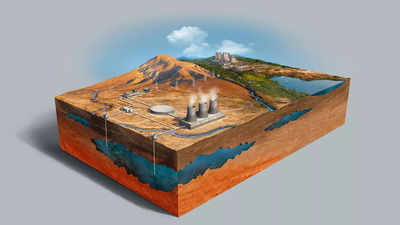- News
- Business News
- India Business News
- India's first geothermal project: ONGC plans June drilling; project may open source of emission-free electricity in Ladakh
Trending
India's first geothermal project: ONGC plans June drilling; project may open source of emission-free electricity in Ladakh
Oil and Natural Gas Corp (ONGC) is gearing up to commence a new drilling initiative in June for India's first geothermal venture in Ladakh. The project aims to establish a sustainable source for emission-free electricity, space heating, and irrigation in challenging landscapes.

Geothermal wells facilitate the transportation of hot water or steam to the surface, which is then utilized to drive a turbine for electricity generation. (Image source: Freepik)
Oil and Natural Gas Corp (ONGC) is gearing up to launch a new drilling campaign in June for India's first geothermal project, following a setback encountered two years ago. The successful completion of this project could potentially unlock a new source of clean electricity, space heating, and irrigation in the challenging terrain of Ladakh.
ET quoted Ravi, the director general of ONGC energy centre who is overseeing the project at Puga in Ladakh, as saying that the company intends to start drilling the first well in the second or third week of June and aims to complete two geothermal wells, each with a depth of 1,000 meters, by the end of September.
If the project progresses smoothly, a power plant with a minimum capacity of 1 MW will be established by the following year. Geothermal wells facilitate the transportation of hot water or steam to the surface, which is then utilized to drive a turbine for electricity generation.
Also Read | Why JPMorgan CEO believes PM Narendra Modi is doing an ‘unbelievable job’
In 2022, ONGC encountered a setback when it had to abandon a well it was attempting to drill due to an uncontrolled high volume of water. This time, the contractor will be equipped with advanced equipment, including a blow-out preventor, to address such challenges. Last year, no drilling contractor expressed interest in the project due to the logistical difficulties involved.
Also Read | Significant milestone! Gautam Adani says Adani Green is now India's first “das hazari” in renewable energy space
"In Puga, we have a limited window for actual work, between June and September. It's too cold after that. Before April, roads are covered with ice and so not accessible," said Ravi, highlighting the challenges posed by cold weather, reduced oxygen levels in the atmosphere, and logistics. Due to the lower oxygen levels, planes are unable to transport very heavy equipment to the project site, and trucks are required to take a longer route as some bridges cannot support heavier loads.
ONGC has already awarded the drilling contract for this summer's project. Third-party inspection of equipment is currently underway at the contractor's sites, and mobilization is scheduled to commence in the first week of May, according to Ravi.
ET quoted Ravi, the director general of ONGC energy centre who is overseeing the project at Puga in Ladakh, as saying that the company intends to start drilling the first well in the second or third week of June and aims to complete two geothermal wells, each with a depth of 1,000 meters, by the end of September.
If the project progresses smoothly, a power plant with a minimum capacity of 1 MW will be established by the following year. Geothermal wells facilitate the transportation of hot water or steam to the surface, which is then utilized to drive a turbine for electricity generation.
Also Read | Why JPMorgan CEO believes PM Narendra Modi is doing an ‘unbelievable job’
At Puga, water temperatures are expected to reach 220 degrees centigrade. The steam generated can be initially used for electricity production and subsequently for space heating, aqua farming, and herbal spa applications. ONGC is receiving guidance from consultants based in Iceland, a nation that relies on geothermal energy for two-thirds of its primary energy needs.
In 2022, ONGC encountered a setback when it had to abandon a well it was attempting to drill due to an uncontrolled high volume of water. This time, the contractor will be equipped with advanced equipment, including a blow-out preventor, to address such challenges. Last year, no drilling contractor expressed interest in the project due to the logistical difficulties involved.
Also Read | Significant milestone! Gautam Adani says Adani Green is now India's first “das hazari” in renewable energy space
"In Puga, we have a limited window for actual work, between June and September. It's too cold after that. Before April, roads are covered with ice and so not accessible," said Ravi, highlighting the challenges posed by cold weather, reduced oxygen levels in the atmosphere, and logistics. Due to the lower oxygen levels, planes are unable to transport very heavy equipment to the project site, and trucks are required to take a longer route as some bridges cannot support heavier loads.
ONGC has already awarded the drilling contract for this summer's project. Third-party inspection of equipment is currently underway at the contractor's sites, and mobilization is scheduled to commence in the first week of May, according to Ravi.
End of Article
FOLLOW US ON SOCIAL MEDIA
















